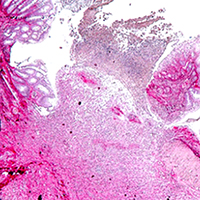Anastomotic healing in a rat model of peritonitis after non-steroidal anti-inflammatory drug administration

Submitted: 12 November 2019
Accepted: 27 December 2019
Published: 10 January 2020
Accepted: 27 December 2019
Abstract Views: 958
PDF: 612
HTML: 12
HTML: 12
Publisher's note
All claims expressed in this article are solely those of the authors and do not necessarily represent those of their affiliated organizations, or those of the publisher, the editors and the reviewers. Any product that may be evaluated in this article or claim that may be made by its manufacturer is not guaranteed or endorsed by the publisher.
All claims expressed in this article are solely those of the authors and do not necessarily represent those of their affiliated organizations, or those of the publisher, the editors and the reviewers. Any product that may be evaluated in this article or claim that may be made by its manufacturer is not guaranteed or endorsed by the publisher.

 https://doi.org/10.4081/ejh.2020.3085
https://doi.org/10.4081/ejh.2020.3085






